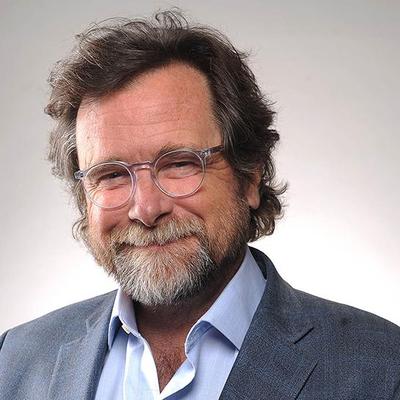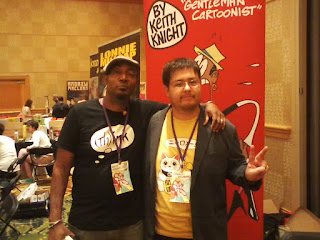SPX 2017 Panel - Troubled Teenagers and Modern Times
Panelists Mardou(Sky In Stereo), Charles Forsman (The End Of The Fucking World, This is Not Okay), Sean Knickerbocker (Killbuck), Melissa Mendes (Lou, The Weight) and Nate Powell (Any Empire, Swallow Me Whole), led by moderator Craig Fischer, discuss how they are able to realistically and empathetically create vivid teenage characters who are struggling with morality, mental illness, drugs and the pressures of society.
SPX 2017 Panel - Barometer of the Free Press
Tom Spurgeon moderates a discussion among political cartoonists Ann Telnaes, Matt Wuerker, Keith Knight and Ben Passmore as they expand on the subject of Telnaes' keynote speech at the Canadian Committee for World Press Freedom luncheon in Ottawa. The panelists explore the role and responsibility of political cartoonists/satirists in a time when the freedom of the press is under attack.
SPX 2017 Panel - Genderfluidity, Technology and Futurism
L.Nichols moderates this panel on the recent movement in comics toward exploring genderfluidity within a science-fiction context, with an emphasis on technology and utopian ideals. Jeremy Sorese (Curveball), Carta Monir (Secure Connect), Kevin Czap (Fütchi Perf) and Rio Aubry Taylor (Jetty) each discusses how their own work fits into this bold new vision of comics.
SPX 2017 Panel - Gilbert Hernandez & Jim Rugg in Conversation
With Love & Rockets, legendary cartoonist Gilbert Hernandez helped create one of the most lauded comic series of all time. Pittsburgh cartoonist Jim Rugg has built a loyal fanbase with Street Angel, a beloved indie comic about a sword-wielding skateboarder and her heroic adventures. These two celebrated cartoonists discuss craft and practice, as well as their views on technology, culture, industry, and staying prolific while relevant in today's comic landscape.
SPX 2017 Panel - Filling in the Pieces: Comics Biography
When doing a comics biography, how do cartoonists approach the material they have at hand? For Box Brown, who did a biography of Andre the Giant, he struggled to find material that might reveal the wrestler's inner life. Anais Depommier had to sift through a mountain of material for her biography of Jean-Paul Sartre, a task made all the more difficult considering how much the philosopher wrote about himself. Luke Howard had to deal with a historically and racially sensitive topic in ragtime creator Ernest Hogan. Moderator Chris Mautner leads the discussion. Anais Depommier appears courtesy of a grant by The Cultural Services of the French Embassy.
SPX 2017 Panel - Fukushima Devil Fish:Susumu Katsumata's Anti-Nuclear Manga
Critiques of nuclear energy in Japanese manga did not begin with the Fukushima Daiichi meltdowns in 2011. One of the regulars of the legendary alternative manga monthly Garo in the magazine's heyday of the late 1960s and early 1970s, Susumu Katsumata (1943-2007) has the curious distinction of having risen within the world of political cartooning and literary comics while studying toward a graduate degree in nuclear physics in Tokyo. In the late 70s, he began drawing frequent humor strips about the dangers of nuclear power and stories about the "nuclear gypsies" who maintained Japan's nuclear plants under oppressive work conditions. This talk surveys Katsumata's work on the subject of nuclear power, which is the largest, most diverse, and most trenchant such oeuvre in Japanese visual art. Ryan Holmberg offers a preview of two of his upcoming publications with this wide-ranging visual survey, a collection of Katsumata's manga titled Fukushima Devil Fish (SISJAC and Breakdown Press) and No Nukes for Dinner.
SPX 2017 Panel - Kick-Ass Annie-Versary: Koyama Press Turns Ten
Annie Koyama has championed the work of emerging cartoonists for 10 years. As a leading publisher of underground comix, her roster features the work of many of today's top names in the indie comics scene, including Michael DeForge, Aidan Koch, Alex Schubert, Daryl Seitchik, and many more. KP artists Patrick Kyle, Eleanor Davis, Dustin Harbin, Hannah K. Lee, and Ben Sears assemble in a very special panel spotlighting one our favorite curators of small press cartoonists and their work. Moderated by Rob Clough of High-Low.
SPX 2017 Panel - Mental Illness, Motherhood and Memoir
A new trend in memoir comics is an exploration of motherhood and the ways in which mental illness and societal forces have a profound effect on the experience. Keiler Roberts (Sunburning), Luke Howard (Our Mother), Tyler Cohen (Primahood: Magenta) and Summer Pierre (Paper Pencil Life) provide their perspectives on the topic, both from the point of view of mother and child. Moderated by Rob Clough.
SPX 2017 Panel - The Serious Business of Humorous Memoir
Panelists Keith Knight (K Chronicles), November Garcia (Foggy Notions), Glynnis Fawkes (Reign Of Crumbs), and Jennifer Hayden (The Story Of My Tits) discuss will explain how their focus on the funnier side of their lives doesn't stop them from exploring serious issues as well. For some of these cartoonists, humor is an important tool in diffusing the gravity of their circumstances. Moderated by Marc Sobel.
SPX 2017 Panel - Shock Humor, Farce and Satire
In a world that seems increasingly difficult to satirize, learn how cartoonists Tommi Musturi (Simply Samuel), Aaron Lange (Trim), Sabin Cauldron (Maleficium), and Katie Fricas (The New Yorker) use different comedic tools to address the absurd, the awful and the just plain ridiculous. Moderator Heidi MacDonald keeps track of each artist's approach and how their view of the world colors their senses of humor. Tommi Musturi appears courtesy of the Finnish Literature Exchange.
SPX 2017 Panel - Trump Presidential Library
Celebrants and detractors alike are chewing on the fact that Donald Trump was elected president. Shannon Wheeler and Robert Sikoryak help you swallow. In their books, "Sh*t My President Says," from Top Shelf and, "The Unquotable Trump," from Drawn & Quarterly (respectively), these two cartoonists illustrate Trump's words for comedic effect and insight. There are slides, a brief history of political satire and politics in comic books, and laughter through the tears as they wrestle with an understanding of our current dystopia. Can satire keep up with reality? Shannon Wheeler is the two-time Eisner winning creator of, "Too Much Coffee Man," and a New Yorker cartoonist. Robert Sikoryak started at Raw magazine, is a New Yorker contributor, and the author of, "Terms and Conditions," from Drawn & Quarterly.
SPX 2017 Interviews - Creator Debuts and Highlights
Jack Russell from TheApogeeks.com interviews select creators debuting new work at Small Press Expo 2017 and share a few highlights from the show.






















